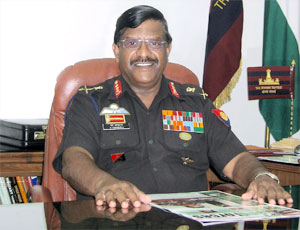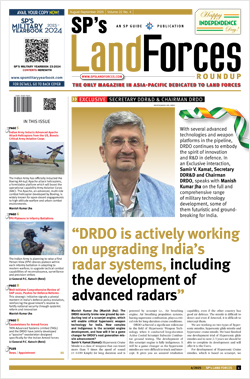INDIAN ARMED FORCES CHIEFS ON OUR RELENTLESS AND FOCUSED PUBLISHING EFFORTS

The insightful articles, inspiring narrations and analytical perspectives presented by the Editorial Team, establish an alluring connect with the reader. My compliments and best wishes to SP Guide Publications.

"Over the past 60 years, the growth of SP Guide Publications has mirrored the rising stature of Indian Navy. Its well-researched and informative magazines on Defence and Aerospace sector have served to shape an educated opinion of our military personnel, policy makers and the public alike. I wish SP's Publication team continued success, fair winds and following seas in all future endeavour!"

Since, its inception in 1964, SP Guide Publications has consistently demonstrated commitment to high-quality journalism in the aerospace and defence sectors, earning a well-deserved reputation as Asia's largest media house in this domain. I wish SP Guide Publications continued success in its pursuit of excellence.
- India's Operation Sindoor Sends a Clear Message to Terror and the World – ZERO TOLERANCE
- Japan and India set forth a defence cooperation consultancy framework, talks on tank and jet engines
- Lt General Pratik Sharma takes over Command of Indian Army's Northern Command
- Major General Lisamma P.V. assumes the appointment of ADG, MNS
- Uzbekistan's progressive transformation is a bright spot in Central Asia; boosts cultural ties with India
- Terrorist Attack in Pahalgam in Kashmir: Unfolding a long surgical war against PAK
Pragmatic Approach to Modernisation

SP's: The dynamically evolving global and regional security environment is giving rise to new forms of security challenges. Is the Indian Army currently structured and organised to meet futuristic challenges?
Lieutenant General Noble Thamburaj (VCOAS): The nature of warfare is changing and evolving rapidly. There is a significant overlap today between External Threats, Proxy War, Counter Insurgency and Counter Terrorism operations. Internal and External security have today become inextricably linked. We are fully alive to this transition. The Indian Army therefore needs to remain prepared and trained to fight across the spectrum of conflict. We also need to build credible 'Out of Area Contingency' capabilities to protect our interests and to render military assistance to friendly countries, including humanitarian assistance or disaster relief, when mandated. Accordingly, our defence capability planning is based on a 'Threat cum Capability' based approach with focus on upgradation of our operations capability, through modernization, force restructuring, technology absorption and commensurate infrastructure development in a phased manner. Concurrently, HRD is being given a renewed focus to facilitate induction of quality manpower to support a technology oriented Army. We are also consciously working towards preparing our leadership to acquire skills to be able to respond dynamically to the changing security paradigm.
SP's: The Indian Army has pragmatic modernisation programme. What kinds of capabilities are being developed to enable the Indian Army to meet futuristic threats? What are the priorities for induction of technology?
VCOAS: Modernisation is a complex and dynamic process impacted by operational challenges, emerging technologies and budgetary support. Review of modernization of Indian Army is a periodic institutional exercise which is conducted regularly, wherein force levels, gestation periods as well as life time support of equipment are assessed against the capabilities desired. The resultant outputs form the basis for formulation of the Long Term Perspective Plans (covering 15 years period), Service Capital Acquisition Plans (5 year plans) and Annual Acquisition Plans.
The 11th Defence Plan has earmarked a substantial component of the budget for modernisation. The focus is on precision fire power, air defence, aviation, Future Infantry Soldier as a system, infrastructure development, network centricity and achieving battle field transparency through improved surveillance, night vision and target acquisition.
SP's: With the defence budget hovering around 2% of GDP, we feel that it is not possible to modernize and prepare the Army to cater for the future threats and challenges whose trend are already visible on the horizon. What measures are being taken to ensure that planned modernization continues without being affected by financial challenges?
VCOAS: Adequate defence outlay has been earmarked by the Government to meet the genuine defence requirements. Government has time and again assured that enhanced defence outlay will be made available, as and when required, to achieve the modernization goals. With the formulation of DPP 2008 and reforms in procurement procedures, the pace of capital procurement has increased, resulting in overall enhanced combat effectiveness and utilization of allocated financial outlay.
SP's: Does our force planning which primarily hinges on 'Capability and Threat' based approach, cater to the challenges of sub conventional war, which the Indian Army is deeply involved with?
VCOAS: The intended shift from the 'Threat Based' to a 'Threat cum Capability Based' force development strategy adequately meets the envisaged future challenges. Given the prevailing security scenario, the future shape of the Army needs to cover capabilities across the spectrum of conflict, of which sub-conventional war forms an important determinant. Recognising that the Army's involvement in LICO is likely to continue in the foreseeable future, we are focused in honing capabilities to be able to effectively deal with internal conflict situation such as externally abetted proxy war, insurgency, militancy and urban terrorism.
SP's: Emerging trends indicate exploitation of Space for military purpose. How are various Space vectors being developed to optimize our operational capabilities? What is your take on a Space Command?
VCOAS: The trend towards usage of Space based military applications has increased manifold the world over in the past decade. More and more nations are enhancing their Space based capabilities for military purposes.
The growing importance of Space has necessitated the Indian Army to take numerous initiatives for optimum exploitation of Space, which include formulation of Army Space Vision 2020, creation of Army Space Cells at various levels, Space related training and enhanced representation in Space related defence Committees.
Since Space is Tri-Service domain and Space capabilities come at a huge cost, have global coverage and require highly trained manpower, there would be a need to set up a Tri-Service organization for optimising different functions of Space at various levels. While presently an Integrated Space Cell has been established in HQ IDS, in due course, we envisage the creation of a Tri-Services Space Command. Army being the largest user of space based application, would contribute appropriately to the Space Command.
SP's: Deployment of Unmanned Combat Aerial Vehicle (UCAV) by US Forces has added a new dimension in the application of force. What measures have been taken to acquire this capability for the Indian Army?
VCOAS: Armed UAVs have played an important role in recent times. They are known for their ability to conduct missions in moderate-to-high-risk situations without fear of loss of life. Indian Army has analysed their usage in detail and their induction is envisaged as part of our modernization plans.
SP's: In the ongoing 11th Army Plan, what are our plans to enhance the night fighting capabilities and battle field awareness?
VCOAS: Enhancing the night fighting capability of the Indian Army is a priority focus area. Toward this end, our endeavour is to achieve complete removal of night blindness of Infantry, Mechanised forces and other combat support units & systems. Intelligence, surveillance and reconnaissance (ISR) capabilities are also being enhanced in a phased manner, to increase situational awareness in the area of interest. We are hopeful of achieving requisite capabilities during the 11th Army Plan period.
SP's: The vision statement of Indian Army envisages capability to operate effectively in an integrated joint service environment. What measures are being contemplated for achieving tri-Services synergy and operational effectiveness?
VCOAS: The history of military warfare has clearly demonstrated that no single component of military power, be it land, maritime or air can win wars alone. It is an operational imperative therefore to synergise and optimise the capabilities of the three services for joint war fighting.
The three services have made a start towards achieving jointness in various operational, training and administrative fields. We have made significant strides by setting up HQ Integrated Defence Staff, establishment of the Defence Intelligence Agency, creation of a Tri-Service Andaman and Nicobar Command and the Strategic Forces Command. At functional level, it exercises are being conducted regularly. All this is leading us towards greater understanding of each other's capabilities and constraints. HQ IDS and the Service HQs have been jointly developing various joint warfighting doctrines and concepts. However, a lot still remains to be done. The appointment of CDS to provide 'single point' advice to the Government is a priority. In the future, there is a need to create Joint Functional Commands in specified areas and ultimately Joint Theatre Commands to achieve true Tri-Service synergy.
SP's: How is Indian Army balancing the dual demand of futuristic force development with investment in current technology that ensures operational preparedness and balance mix of old, contemporary and futuristic technologies?
VCOAS: Induction and modernisation of equipment/weapon system in a large Army like ours, has to be organised in a pragmatic manner. Considering the receding span of technological cycle, right balance has to be maintained between state of art, current & obsolescent technologies. To ensure this our modernization programme has envisaged having an appropriate mix of weapon/equipment, comprising 30% state of art technology, 40% based on current technology & 30% equipment nearing obsolescence, which can be upgraded.
SP's: Defence Procurement Procedure (DPP-2008) reasonably streamlined the procurement procedure. However, procedural complexities are still causing delay in Procurement, impeding the modernisation process of Indian Army. What measures are being contemplated to reduce lead time for procurement?
VCOAS: A number of measures have been taken to ensure optimum realisation of modernisation plans with maximum utilisation of Capital Budget allocations. Evolution of Annual Acquisition Plans after detailed deliberations and their periodic reviews has helped in monitoring the progress and give an impetus to the modernisation plan. Streamlining of Procurement processes as related to formulation of General Staff Qualitative Requirements, Scaling, categorisation, Request for Proposal, Trials and Transfer of Technology etc is reviewed regularly. The Army is confident that these measures will ensure force modernization is accomplished, as envisaged.





